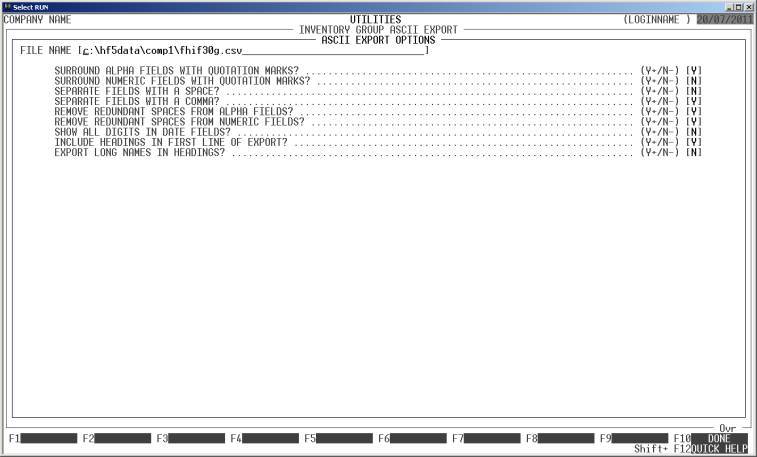HiFinance
5
SECTION 7.2.3.1.7 - INVENTORY GROUP ASCII EXPORT
USAGE: To export a file detailing
all or a subset of the information on the Inventory Group master-file. This export
file can then be used as input to other programs, such as Spreadsheets,
Databases and Word-processors. This gives you the flexibility to format
reports, etc. in ways not otherwise available in HiFinance.
The file will always be created in Inventory Group
code order.
DISCUSSION:
The screen will clear and you will be asked the
following questions:
UP TO YEAR [ ] (L)ast,
(T)his or (N)next year. PERIOD [..]
This report is
generated up to a period. By default, this is the current period but you can change
the period if you wish. Backdating does not undo the report to the status as it
was at the end of that period. Eg if you have back-dated an invoice, it will be
included in the report in the month it relates to. Also, the stock-on-hand
figures are the current figures.
Enter a year, eg L for last year, T for this year or N for next year. Then enter the period number, 1 - 12, within that year. Note
that next year can only have periods 1
- 3.
LIMIT REPORT TO LOCATION This question is only relevant to companies using
multi-location stock. In this case, you may either choose to print the report
for one location or the combined total for all locations.
INCLUDE ALL INVENTORY
GROUPS If you do not wish to set any limits on the
report, enter Y otherwise enter N. If you enter N, you will be asked a list
of further questions.
FROM GROUP This is the lower limit of the Inventory Group code.
Here you enter the code of the first Group you wish printed. The default answer
is blank. This will start printing from the start of the Inventory Group file.
TO GROUP This is the upper limit of the Inventory Group code.
Here you enter the code of the last Group you wish printed. The default answer
is zzzzzzzzzzzzzzz. This will end printing at the
end of the Inventory Group file. This entry must not be less than the starting
Group code. If you choose the default for both questions all Inventory Groups
will be included.
At each point when answering
the above questions, you can press <ESC> and the program will reset
and return you to the INVENTORY GROUP
MENU.
Next you will be asked for the export file name and
options. A full explanation of the fields may be found in FORMATTING ASCII
EXPORT FIELDS (see SECTION B). If you are using
the export function for the first time, you are strongly encouraged to view
this section of the manual. To end this page, press <F10> or <Enter> past the last option. You
will next be presented the following screen:

This screen relates to the exact fields you wish to
export. The top of this screen displays the file name you will be exporting, as
a reminder. The centre portion of the screen displays the short name of each
field available for export. Next to this is a longer, more descriptive name
(which can be exported instead of the short-name). On the right-hand-side is
either a Y or N. If the field has a Y, the field will be included
in the export. If the field has an N, the field will not be
exported. You must choose at least one field to export. You may use the cursor
keys to view all fields, as you would in search screens. You can change the INCLUDE column by moving the highlight bar to the relevant
field and entering a Y or N (or + or -). The bottom of the screen displays the number of fields you have
chosen and the total possible number of fields.
There are also function keys available for
manipulating FIELD NAMES:
<F1> This will only be available is the current field is
not being exported. Pressing <F1> will change INCLUDE status to Y.
<F2> This will only be available is the current field is
being exported. Pressing <F2> will change INCL status to N.
<F4> This will return you to the FILE NAME and OPTIONS entry screen.
<F5> This will only be available if at least one of the
fields has been excluded from the export. Pressing this key will change all
fields to Y.
<F6> This will only be available if at least one of the
fields has been included in the export. Pressing this key will change all
fields to N.
<F8> This will restore the field choices to the state
that they were before you entered the program.
<F10> When you have finished choosing the fields you wish
exported, press <F10> to start the export
process. This option will not be available unless at least one field has been
chosen for export.
When you have entered all the above information,
press <F10> and you will be asked START FILE CREATION? If you answer N, the
program will reset and return you to the INVENTORY
GROUP MENU. If you enter Y, the screen will clear and
the Inventory Group master-file will be read in. During this time the computer
will be selecting account records according to the selection criteria you have
just entered will start writing the selected fields to the export file.
Like other reports, it is possible to stop the
export of the ASCII file by pressing <ESC>. However, the ASCII file
will have been created up to the point where you stopped it.
When the report has completed, HiFinance will return
you to the INVENTORY GROUP MENU.